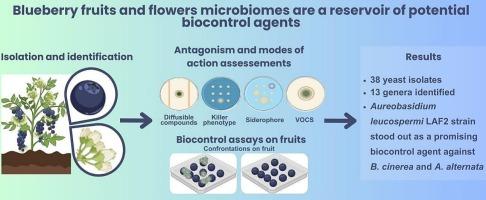揭示了本土蓝莓衍生酵母作为葡萄孢和互交霉病生物防治剂的潜力
IF 3.4
2区 农林科学
Q2 BIOTECHNOLOGY & APPLIED MICROBIOLOGY
引用次数: 0
摘要
阿根廷的蓝莓生产面临的经济损失主要是由真菌病原体造成的,如灰葡萄孢菌和交替孢霉。合成杀菌剂预计将被停止使用,以支持更可持续的农业,使保护植物的本地酵母成为一个有希望的替代品。本研究对蓝莓果实和花的可栽培部分附生酵母菌群落进行了探索,以确定能够保护果实免受主要植物病原体侵害的酵母菌。利用pcr扩增的26S rRNA基因D1/D2结构域对原生酵母进行了分离鉴定。鉴定出Rhodotorula、Hanseniaspora、Naganishia、Moesziomyces、Rhizosphaera、Metschnikowia、Clavispora、Pallidophorina、Hannaella、Aureobasidium、Sporobolomyces、Filobasidium和Cystobasidium属成员。随后,在体外和体内评价了对灰绿芽孢杆菌和交替芽孢杆菌的拮抗作用。最后,对杀伤表型、铁载体的产生和挥发性有机化合物(VOCs)的形成等潜在作用方式进行了评价。在所鉴定的38株酵母菌中,在25℃条件下,金黄色葡萄球菌(auobasidium leucospermi LAF2)对蓝莓果实的体外和体内防虫效率分别为58.33%和67.78%。同时也证明了其产生羟基酸型铁载体和VOCs的能力,其抑制灰绿杆菌生长的能力为48.19%。这些结果表明,果实和花卉附生微生物群落是潜在生物防治剂的储存库。a . leucospermi LAF2是蓝莓生产中合成杀菌剂的可持续替代品。本文章由计算机程序翻译,如有差异,请以英文原文为准。

Unveiling the potential of native Blueberry-derived yeasts as biocontrol agents against Botrytis cinerea and Alternaria alternata
Blueberry production in Argentina faces economic losses caused mainly by fungal pathogens such as Botrytis cinerea and Alternaria alternata. Synthetic fungicides are expected to be discontinued in favor of a more sustainable agriculture, making indigenous yeast, which protects the plants, a promising alternative. This study explored the cultivable portion of blueberry fruits and flowers epiphytic yeast community to identify yeasts capable of protecting fruits against the major phytopathogens affecting this crop. Native yeasts were isolated and identified based on the PCR-amplified and sequenced D1/D2 domains of the 26S rRNA gene. Members of the genera: Rhodotorula, Hanseniaspora, Naganishia, Moesziomyces, Rhizosphaera, Metschnikowia, Clavispora, Pallidophorina, Hannaella, Aureobasidium, Sporobolomyces, Filobasidium, and Cystobasidium were identified. Subsequently, antagonism against B. cinerea and A. alternata was assessed in vitro and in vivo. Finally, potential modes of action such as killer phenotype, siderophore production and formation of volatile organic compounds (VOCs) were also evaluated. Among 38 yeast strains identified, the strain Aureobasidium leucospermi LAF2 stood out in vitro and in vivo with respect to protect blueberry fruits against B. cinerea by 58.33 % and A. alternata by 67.78 % of biocontrol efficiency at 25 °C. It also proved the ability to produce hydroxamate-type siderophores and VOCs capable of inhibiting B. cinerea growth by 48.19 %. These results suggest that fruits and flowers epiphytic microbial communities are a reservoir of potential biological control agents. A. leucospermi LAF2 is a strong candidate for a sustainable alternative to synthetic fungicides in blueberry production.
求助全文
通过发布文献求助,成功后即可免费获取论文全文。
去求助
来源期刊

Biological Control
生物-昆虫学
CiteScore
7.40
自引率
7.10%
发文量
220
审稿时长
63 days
期刊介绍:
Biological control is an environmentally sound and effective means of reducing or mitigating pests and pest effects through the use of natural enemies. The aim of Biological Control is to promote this science and technology through publication of original research articles and reviews of research and theory. The journal devotes a section to reports on biotechnologies dealing with the elucidation and use of genes or gene products for the enhancement of biological control agents.
The journal encompasses biological control of viral, microbial, nematode, insect, mite, weed, and vertebrate pests in agriculture, aquatic, forest, natural resource, stored product, and urban environments. Biological control of arthropod pests of human and domestic animals is also included. Ecological, molecular, and biotechnological approaches to the understanding of biological control are welcome.
 求助内容:
求助内容: 应助结果提醒方式:
应助结果提醒方式:


